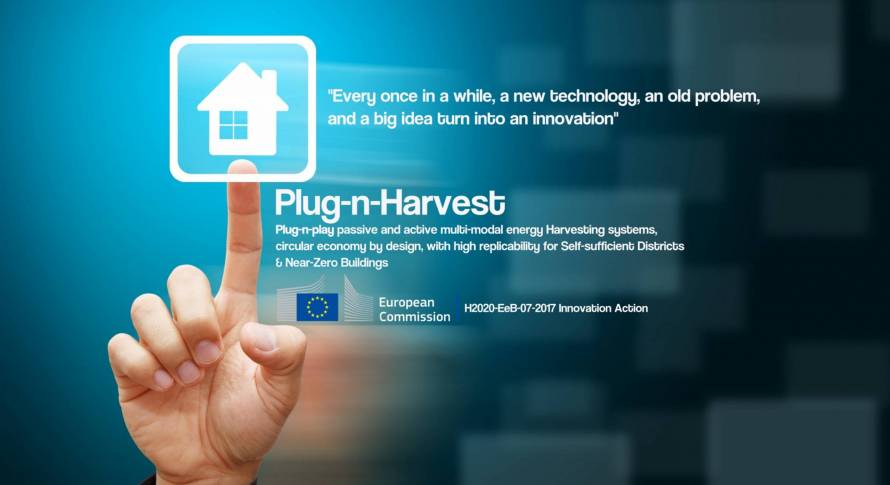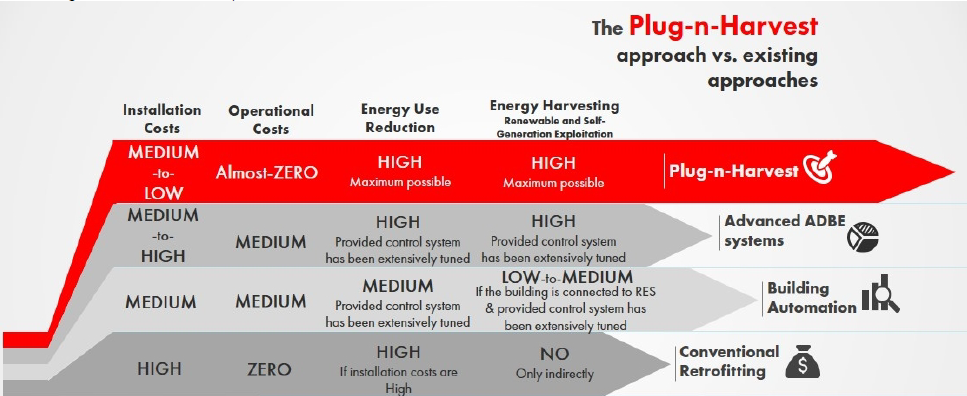
PLUG-N-HARVEST – The modular circular economy façade system
Plug-n-play passive and active multi-modal energy Harvesting systems, circular economy by design, with high replicability for Self-sufficient Districts & Near-Zero Buildings
The main strategic goal of the PLUG-N-HARVEST proposal is to design, develop, demonstrate and exploit a new modular, plug-n-play concept/product for ADBE(Adaptable/Dynamic Building Envelopes) – deployable to both residential and non-residential buildings – which is able to provide high (maximum possible) energy use reductions and high (maximum possible) energy harvesting from RES(Renewable Energy Sources) both at the single-building and the district scale while requiring medium-to-low installation costs and almost-zero operational costs. Moreover, by appropriately exploiting its modular and plug-n-play attributes, the PLUG-N-HARVEST system will be designed and implemented considering circular economy principles, which will allow implementing new business models based on leasing and renting modes and, by this, leaving the door open to massive implementation of such solutions.

How does it work
PLUG-N-HARVEST system aspires transforming static building envelopes to active ones by deploying off-the-shelf energy harvesting, storing and thermal comfort affecting elements able to dynamically adapt to available exogenous energy assets. In order to enable maximum-exploitation of the available, free environmental energy in a user and micro-climate (indoor and outdoor) oriented manner, PLUG-N-HARVEST enhances their operational capabilities by imposing intelligence, adaptation, cognition, security and safety ICT(Information and Communications Technology)-based mechanisms at a building and district level. The foreseen architectural topology comprises four main functional layers according to their responsibilities and origin: (i) Adaptive Dynamic Building Envelope (ADBE): consisted by flexible aluminum façade design with high insulation layer and energy-harvest enabling elements, (ii) Interconnected Elements Ecosystem (IEE): interconnection of existing and new sensing and controllable elements within a unified network, (iii) Security and Safety Mechanisms (SSM): consisted by safety and security preserving elements forming an encrypted, ICT-based shield for the acceptable operation of the developed digital modules of PLUG-N-HARVEST, and; (iv) Energy Management Systems (EMS): consisted by interoperable ICT-based energy management tools at building (IMCS) and district scale (DRFFO and OEMS).
Circular Solution
Besides the smart and energy effective aspects addressed by the Plug-n-Harvest modular system, material recovery and re-introduction is the other main advantage. Circular economy design requirements are stated as the basis both for product and business model design, always using as methodological framework the Cradle to Cradle Certified(TM) Products Program.
EIG is developing this tasks (Definition of Circular Economy Design Delimitants and Constraints, which will include a materials database webtool), together with Aiguasol (Business and exploitation plan).
FIrst deliverables of this workpakage will be published during 2018.
Project Consortium
The formed consortium has been shaped of thirteen (13) partners from five (5) European countries.The project combines different key players and organisation in order to ensure a multifarious cooperation, bringing together expertise from academic and research community (3), public authorities, municipalities, agencies (3), industry (3) and SMEs(Small and Medium-sized Enterprises) (4), regarding leading-edge technological topics.
More information: Plug-n-Harvest website
The Plug-n-Harvest project has received funding from the European Union’s Horizon2020 research and innovation programme under grant agreement number 768735.
